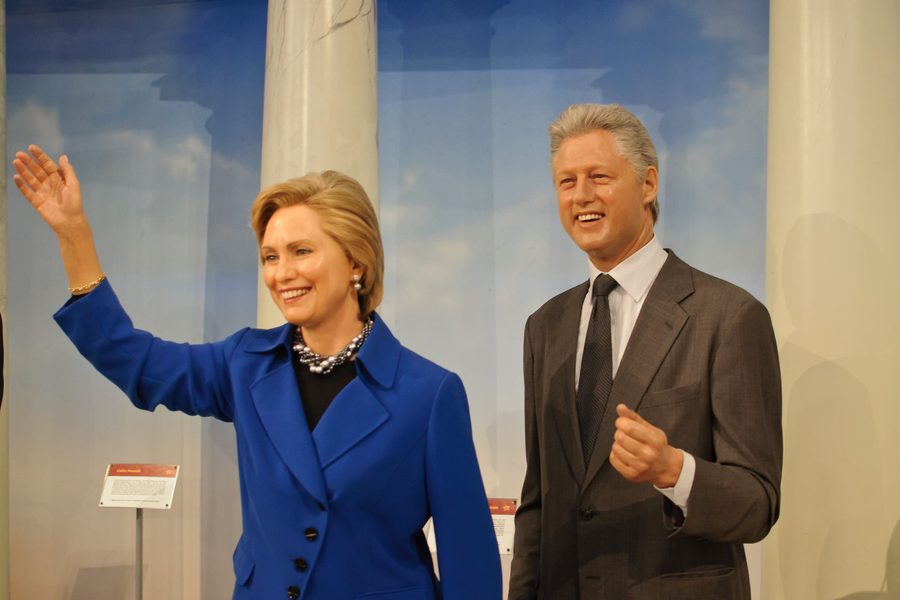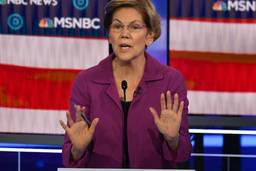The Clintons’ Dominance of Democratic Politics Is Over—And They Will Not Be Remembered Fondly
Self-inflicted wounds, an out-of-touch candidate and a party more concerned about Wall Street than the working class sealed the Clinton campaign’s defeat.
Kathleen Geier

In the aftermath of a political catastrophe as devastating of the election of Donald Trump as president of the United States, you’ve got two choices. You can blame the elites or blame the people. I’m gonna go with the elites.
Many liberal journalists, however have taken the opposite view. To paraphrase Bertolt Brecht, in the aftermath of Hillary Clinton’s stunning loss, they have demanded that we dissolve the people and elect another. The Clintonistas have attempted to pin the blame for this fiasco on the voter groups they detest the most: the white working class, the millennials, and the Left. Clinton supporter Jill Filipovic opined that Hillary was too good for us: “Sorry America, you didn’t deserve her,” she tweeted. Many other Clintonites in the media concurred. To Virginia Heffernan, Hillary Clinton was not just a candidate. Instead, she “is an idea, a world-historical heroine, light itself” who “did everything right in this campaign… She cannot be faulted, criticized, or analyzed for even one more second.”
But outside the pro-Clinton media bubble, ordinary Americans had a far less rosy view of Dear Leader Hillary.
Clinton came within striking distance of winning this thing; that much is clear. Normally, when, like Hillary, you begin your campaign with approval ratings that are already under water, and you’re also running when your own party has held the White House for two consecutive terms, I’d say it would be an uphill climb to victory. On the other hand, Hillary was running against Donald Trump, a man who, at the time of the election, was despised by even more people than she was. Against a normal Republican like McCain or Romney, Hillary probably would have lost decisively. But against Trump, she was the odds-on favorite. The polls were tight but they almost always showed Hillary in the lead. And it ended up being a close, and therefore winnable, election. The margins were close enough that a competently run campaign could and should have put Clinton over the top.
What we saw instead was gross political malpractice on the part of Democratic Party elites generally and Team Clinton specifically. Yes, factors outside of the campaign’s control, ranging from the Comey letter to racism, sexism, and more, surely contributed to her defeat. But it’s also become clear that a series of fatal miscalculations and spectacular strategic blunders by the party and the Clinton campaign is what ultimately sealed their candidate’s fate.
Here are some of them:
1. This one isn’t so much why-Hillary-lost but why-the-Democrats-lost: the Clintons did the most thorough job of clearing the Democratic primary field of any candidate in modern history. They threw their weight around and made certain that they had endorsements and support from just about every major donor, party official, party organization, and interest group organization (such as labor, reproductive rights groups, environmental groups, etc.).
The Clintons have a history of punishing perceived disloyalty, so it’s easy to see why these groups knuckled under. Every potential candidate stayed out except Bernie, who shocked everyone when what was supposed to be a protest candidacy turned into a major threat. But if the primary process had been open and competitive, we almost certainly would have ended up with a stronger and more popular candidate. I don’t know who that would have been – maybe Elizabeth Warren, maybe Joe Biden, maybe Sherrod Brown, maybe Kirsten Gillibrand, maybe someone else. In any case, the party, and the country, would have been far better off. Democratic Party elites share the blame here, because they never challenged the Clintons’ attempts to ensure a coronation.
2. Clinton also shot herself in the foot by her own arrogant behavior. Setting up the private email server at the State Department, making those buckraking Wall Street speeches, refusing to cut her ties to the Clinton Foundation (and thus avoid the appearance of a conflict of interest) – all of those were Clinton’s freely made choices, and as such they were completely avoidable.
Yes, the email scandal was a load of bunk, but why in the world would she make the stupid decision to set up a private server in the first place, which gratuitously provided endless rounds of ammunition for her many political enemies? She knew she’d be running for president again, and it’s not like the right hasn’t been hellbent on destroying her for, oh, the past quarter-century or so. It’s worth pointing out that President Obama has had the discipline and smarts to avoid that kind of self-destructive behavior. He and his administration never gave off the faintest whiff of scandal, which is why his enemies were never able to bring him down, try as they might. Seriously, what was Clinton’s excuse here?
Every one of those dangerous misjudgments was a self-inflicted wound that never stopped bleeding, and confirmed the well-founded perception that Clinton was entitled and out of touch. That Clinton never seemed to learn from her past was an ominous sign that her presidency would have been chockful of similar misadventures. After decades of Clinton drama, the public was weary, and no wonder.
3. Relatedly, when Hillary made these foolish decisions, why didn’t the people around her stop her? And that points to another reason why she lost: the mediocrity of her advisers and campaign staff. The Clintons, who seem to prize loyalty over competence, have a long and troubling history of surrounding themselves with extraordinarily unsavory people – sleazeballs and hacks like Mark Penn, Lanny Davis, and Dick Morris, to name just a few. This time around, there weren’t any members of Team Clinton who seemed quite that clownish, so I assumed the personnel decisions were wiser. From the outside, the campaign look professional and competent. But as we’ve been discovering, that perception belied the reality.
4. There is also abundant evidence that Clinton’s campaign royally screwed up its strategy and badly misallocated resources. Clinton won the popular vote by over 2 million votes yet lost key Rust Belt states by razor-thin margins. Clinton’s much-hyped, data-driven get-out-the-vote operation was a shocking failure. Working with outdated voter lists, it mistakenly targeted large numbers of Trump voters. In Michigan, state and local officials “were running at roughly one-tenth the paid canvasser capacity that Sen. John Kerry (D-Mass.) had when he ran for president in 2004.” In states like Ohio, Team Clinton’s efforts neglected traditional Democratic constituencies like African-Americans in favor of targeting far less favorable demographics like upscale Republican women. Clinton did not appear in Wisconsin, a state that she lost, after the primary in April, and neither did Barack or Michelle Obama. One Clinton official admitted that the campaign didn’t do more in some states where they knew were vulnerable because they were too busy playing mind games with Trump: they believed they “could keep Trump away — by acting overly confident about their chances.” Heckuva job, Team Clinton!
5. Theda Skocpol has cited another factor in Clinton’s loss: the Democrats’ lack of organizational infrastructure in non-urban areas. The GOP has a strong organizational base in these regions, including get-out-the-vote efforts run by the Christian right, the NRA, the Koch organizations, and the Republican Party itself. But the Dems have let their own party organizations wither on the vine, and the unions which were once the Democrats’ stronghold in the critical Rust Belt region have declined dramatically. When it comes to getting voters to the polls in rural areas, the Democrats are now at a tremendous structural disadvantage. To be sure, this a party-wide, rather than a Clinton-only, failure. But Presidents Bill Clinton and Barack Obama bear strong responsibility here. Each them served for two terms but showed little interest in building the party.
6. Finally, perhaps most consequential of all was the campaign’s failure to advance a strong economic message. Team Clinton’s central strategy was not to mobilize the base, but to appeal to crossover voters. That irrepressible Clinton instinct to triangulate reared its ugly head one more time, and the result has been a world-historic catastrophe. Clinton’s ads and messaging stressed the Trump’s déclassé boorishness rather than a populist economic message that would have resonated with working class voters of all races. But the votes of Republican college-educated women they were chasing never materialized, while turnout and Clinton’s vote shares among African-Americans, Latinos, millennials, and working class whites were significantly down from Obama’s in 2012. In stroke of bitter poetic justice, the fruits of Clintons’ own long-ago policies came back to haunt them. NAFTA and other Clinton “free” trade deals devastated the Rust Belt and created the ravaged communities and the despair that compelled many working class voters in those areas pull the lever for the despicable Trump.
A post-election report by the pollster Stanley Greenberg confirms that Clinton’s decision to shun a progressive economic appeal was a fatal error. Greenberg found that “polls showed fairly resilient support with white working class women, until the Clinton campaign stopped talking about economic change.” When the Greenberg team tested a Democratic message attacking Trump for his character vs. a message “demanding big economic changes” and attacking Trump for “supporting for trickle-down and protecting corporate special interests,” they found that the economic message “performed dramatically better,” particularly among key voter groups like millennials, white unmarried women and white working class women.
The election is over, and with it, so it is the Clinton’s quarter-century long domination of Democratic politics. And so lately I’ve been thinking about the Clintons’ historical legacy. It’s not a pretty picture. The neoliberal economic policies of Bill Clinton, which Hillary strongly supported – free trade, deregulation, the obsession with deficit reduction – led to soaring levels of economic inequality, flat or declining wages for most Americans, and record low rates of labor participation. The Clinton crime bill ruined countless lives, especially black lives. Welfare “reform” immiserated poor families and led to a dramatic upswing in rates of extreme poverty. Under the watch of Presidents Clinton and Obama, the Democratic party at the state and local level was allowed to slowly die away. Today, the Democratic party as an institution is probably weaker than it’s ever been at any time in its long history. The Democrats now control none of the three branches of government and only 18 governorships and 13 state legislatures. In the weeks leading up to the election, many political observers were confidently predicting an historic Trump defeat followed by a meltdown of the GOP. But – plot twist! – it’s the Democratic party that has collapsed into a smoking heap of rubble.
Team Clinton repeatedly reassured us that Hillary was the most highly qualified and most hyper-competent person evah! to run for president. They possessed the unshakeable conviction that they, the best and the brightest, could not possibly fail – so much so that on election day, her aides prematurely uncorked the celebratory champagne. So extreme was their recklessness that they actually wanted to run against Trump. Out of the outrageous hubris, complacency, and incompetence of Hillary’s presidential campaign came the Clintons’ horrifying parting gift to America: President Donald Trump. This is where the Clintons led us. Trump’s election, and the nightmare to which America is awakening, is on them. And it is unforgivable.
I suspect that history is not going to look kindly at Bill and Hillary Clinton. No, not very kindly at all.







